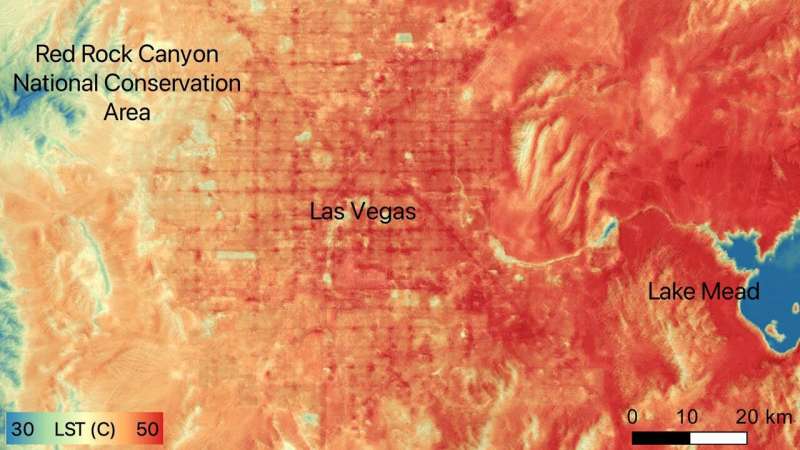NASA's ECOSTRESS instrument recorded ground temperatures around Las Vegas at 5:23 p.m. on June 10. In the city, the hottest surfaces were the dark-colored streets at more than 122 degrees Fahrenheit (50 degrees Celsius). Credit: NASA/JPL-Caltech
An instrument on the space station documented how built and natural surfaces responded to record heat in Las Vegas.
On June 10, Las Vegas reached a record daily high temperature of 109 degrees Fahrenheit (43 degrees Celsius), and temperatures of the ground surface itself were higher still. NASA's Ecosystem Spaceborne Thermal Radiometer Experiment on Space Station (ECOSTRESS) instrument recorded this image of surface temperatures at 5:23 p.m. that day.
Within the city, the hottest surfaces were the streets—the grid of dark red lines in the center of the image. Pavement temperatures exceeded 122 F (50 C), while the exteriors of downtown buildings were a few degrees cooler than paved surfaces. Suburban neighborhoods averaged about 14 F (8 C) cooler than pavement, and green spaces such as golf courses were 23 F (13 C) cooler.
Cities are usually warmer than open land because of human activities and the materials used for building. Streets are often the hottest part of the built environment due to asphalt paving. Dark-colored surfaces absorb more heat from the Sun than lighter-colored ones; asphalt absorbs up to 95% of solar radiation and retains the heat for hours into the nighttime. In this image, patches of dark-colored volcanic rock south of Lake Mead are also noticeably hot.
ECOSTRESS measures the temperature of the ground, which is hotter than the air temperature during the daytime. The instrument launched to the space station in 2018. Its primary mission is to identify plants' thresholds for water use and water stress, giving insight into their ability to adapt to a warming climate. However, ECOSTRESS is also useful for documenting other heat-related phenomena, like patterns of heat absorption and retention. Its high-resolution images, with a pixel size of about 225 feet (70 meters) by 125 feet (38 meters), are a powerful tool for understanding our environment.
More information: ecostress.jpl.nasa.gov/
Provided by NASA
























